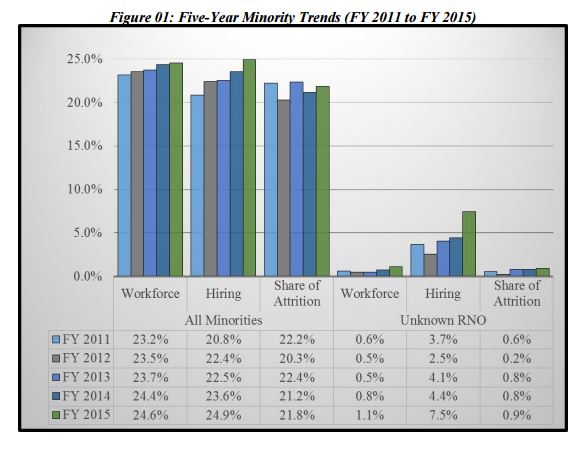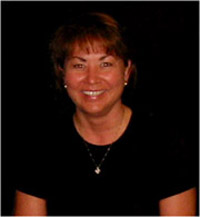
Why the intelligence community declassified its demographics stats for the first time
Minorities made up 24.6 percent of the intelligence community workforce in fiscal 2015, a 1.4 percent increase since 2011, according to the latest workforce...
The intelligence community workforce is more diverse now than it was five years ago. But compared to the rest of the federal and civilian workforces, the IC has fallen behind.
According to the intelligence community’s annual demographics report, minorities made up 24.6 percent of the IC workforce in fiscal 2015, a 1.4 percent increase since 2011. Employees with disabilities represented 7.9 percent of the IC workforce, compared with 5.3 percent five years ago. And the number of women at IC agencies has remained practically unchanged — 38.5 percent of the workforce compared with 38.6 percent in 2011.
“We’re making steady progress, gradual increases in representation with regard to minorities, women and persons of disability in the intelligence community,” Rita Sampson, chief of equal employment opportunity and diversity at the Office of the Director of National Intelligence, said in an interview with Federal News Radio. “We continue to make that progress. However, we are challenged when you compare the intelligence community with the rest of the federal workforce and civilian labor force. You’ll find we have a ways to go.”
Minorities represent 35.4 percent of the federal workforce, for example. Women make up 43.2 percent. And employees with disabilities make up nearly 9 percent of the federal workforce.
With those governmentwide benchmarks in mind, ODNI realized it must take a different approach to recruit and retain a more diverse pool of talent.
“We are refocusing our efforts to make sure that we are trying new approaches,” Sampson said. “The Director of National Intelligence has given us the charge to think very broadly, to move out to areas that we haven’t moved out before. It’s the notion that we have to do something differently.”
The ODNI released its report publicly for the first time this year —an effort to shed more light on the progress the IC has made recently and the hurdles it has yet to overcome to a create a more diverse workforce.
“We’re going to draw some scrutiny, some of it not to our liking,” Director of National Intelligence James Clapper said of the report at the IC Equal Employment Opportunity and Diversity Leadership Summit in Bethesda, Maryland, last month. “But we should draw some scrutiny. That public report is going to put pressure on future leaders to make things better, because we’ll be held even more accountable. That’s another reason why I believe transparency is a good thing.”
The agency created the report at the unclassified level this year and will continue to do so in the future, Sampson said.
“Going public with our demographics is a significant step, but by itself it’s not going to improve minority representation in the intelligence community,” Clapper said. “So if you need permission to think big or to think differently, I’m giving it to you right now.”

By the end of this year, senior executives within all IC elements will also have some sort of diversity and inclusion performance objectives embedded in their performance evaluation plans, the ODNI report said.
The ODNI is working with all 17 IC agencies to develop their own recruitment strategies, where diversity plays a major role. Collectively, the IC is targeting specific colleges and universities with recognized programs in intelligence fields, then appealing directly to professional associations, like the Society for Hispanic Professional Engineers, within those schools.
The IC is also ramping up its online presence, said Deborah Kircher, chief human capital officer for the ODNI. The intelligence community held its first virtual career fairs for current students and prospective job candidates online this year. IC recruitment teams are also reaching out through social media to schools with diverse student populations that they haven’t been able to visit in the past, she said.
“Everybody obviously has a budget and there’s only so many schools that everybody can visit in person, but there’s a lot more we can do online,” Kircher said. “[That’s] good because that’s broadening our aperture and that’s giving us much more visibility, and it’s certainly attracting a lot more students at the virtual perspective.”
But ODNI is also focusing on new ways it can retain pools of diverse talent and help its employees move up to leadership positions within the IC elements. Minorities make up roughly 12 percent of intelligence community employees at senior level pay grades, the ODNI report said.
That effort starts with the right message, Sampson said. ODNI is telling its prospective new employees about the variety of opportunities they have within each of the 17 different IC agencies. Their unique perspectives are crucial to IC mission, she added.
“Within these elements are a range of opportunities that are here and you can invest your long term career and never get bored,” she said. “Those are the things we tell people, that your education, your training, your experience, your background, your culture, all of these things are critical to how we need to do our business, how we advance national security. We want to make sure we’re messaging that, we’re communicating that through onboarding programs from the moment that a person enters the intelligence community, all the way through their career development.”
Copyright © 2025 Federal News Network. All rights reserved. This website is not intended for users located within the European Economic Area.
Nicole Ogrysko is a reporter for Federal News Network focusing on the federal workforce and federal pay and benefits.
Follow @nogryskoWFED
Related Stories





